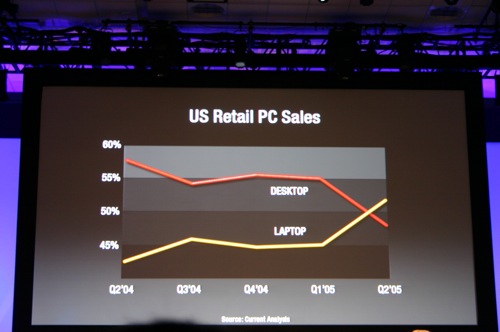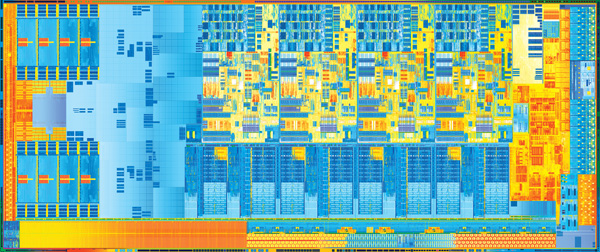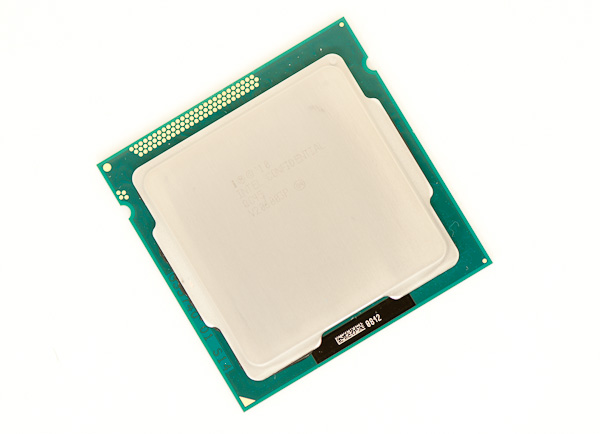The Intel Ivy Bridge (Core i7 3770K) Review
by Anand Lal Shimpi & Ryan Smith on April 23, 2012 12:03 PM EST- Posted in
- CPUs
- Intel
- Ivy Bridge
The times, they are changing. In fact, the times have already changed, we're just waiting for the results. I remember the first time Intel brought me into a hotel room to show me their answer to AMD's Athlon 64 FX—the Pentium 4 Extreme Edition. Back then the desktop race was hotly contested. Pushing the absolute limits of what could be done without a concern for power consumption was the name of the game. In the mid-2000s, the notebook started to take over. Just like the famous day when Apple announced that it was no longer a manufacturer of personal computers but a manufacturer of mobile devices, Intel came to a similar realization years prior when these slides were first shown at an IDF in 2005:
IDF 2005
IDF 2005
Intel is preparing for another major transition, similar to the one it brought to light seven years ago. The move will once again be motivated by mobility, and the transition will be away from the giant CPUs that currently power high-end desktops and notebooks to lower power, more integrated SoCs that find their way into tablets and smartphones. Intel won't leave the high-end market behind, but the trend towards mobility didn't stop with notebooks.
The fact of the matter is that everything Charlie has said on the big H is correct. Haswell will be a significant step forward in graphics performance over Ivy Bridge, and will likely mark Intel's biggest generational leap in GPU technology of all time. Internally Haswell is viewed as the solution to the ARM problem. Build a chip that can deliver extremely low idle power, to the point where you can't tell the difference between an ARM tablet running in standby and one with a Haswell inside. At the same time, give it the performance we've come to expect from Intel. Haswell is the future, and this is the bridge to take us there.
In our Ivy Bridge preview I applauded Intel for executing so well over the past few years. By limiting major architectural shifts to known process technologies, and keeping design simple when transitioning to a new manufacturing process, Intel took what once was a five year design cycle for microprocessor architectures and condensed it into two. Sure the nature of the changes every 2 years was simpler than what we used to see every 5, but like most things in life—smaller but frequent progress often works better than putting big changes off for a long time.
It's Intel's tick-tock philosophy that kept it from having a Bulldozer, and the lack of such structure that left AMD in the situation it is today (on the CPU side at least). Ironically what we saw happen between AMD and Intel over the past ten years is really just a matter of the same mistake being made by both companies, just at different times. Intel's complacency and lack of an aggressive execution model led to AMD's ability to outshine it in the late K7/K8 days. AMD's similar lack of an execution model and executive complacency allowed the tides to turn once more.
Ivy Bridge is a tick+, as we've already established. Intel took a design risk and went for greater performance all while transitioning to the most significant process technology it has ever seen. The end result is a reasonable increase in CPU performance (for a tick), a big step in GPU performance, and a decrease in power consumption.
Today is the day that Ivy Bridge gets official. Its name truly embodies its purpose. While Sandy Bridge was a bridge to a new architecture, Ivy connects a different set of things. It's a bridge to 22nm, warming the seat before Haswell arrives. It's a bridge to a new world of notebooks that are significantly thinner and more power efficient than what we have today. It's a means to the next chapter in the evolution of the PC.
Let's get to it.
Additional Reading
Intel's Ivy Bridge Architecture Exposed
Mobile Ivy Bridge Review
Undervolting & Overclocking on Ivy Bridge
Intel's Ivy Bridge: An HTPC Perspective




















173 Comments
View All Comments
jmcb - Saturday, May 12, 2012 - link
I was thinking the exact same thing.I waited long to jump on the dual core bandwagon, 2008 with a C2D 8400. I havent jumped on the quad core wagon yet. Was waiting for them to run cooler.
This seems like a good time to make the jump.
CeriseCogburn - Friday, June 1, 2012 - link
I'm going to get rid of my 2500K @ 4.8GHz , because it's HD3000 just isn't doing it for BF3,and I'm going Trinity man !
See me and my amd apu on the gaming servers !
a. totally wanna be cool amd fan
b. fantasy boy with lunch money from mommie in pocket
c. bonkers
d. all the above
p05esto - Monday, April 23, 2012 - link
Yea, but WHEN can I buy one? Forgive me if I missed that all important detail. My desktop is 2.5 yrs old and am ready to upgrade here. Show me where to buy, lol.Catalina588 - Monday, April 23, 2012 - link
OEM boxes arrive April 29th. I expect NewEgg will have parts shortly thereafter.tiki037 - Wednesday, April 25, 2012 - link
+1I thought the April 23 launch date meant that was when we would be able to buy one.
Tommyv2 - Monday, April 23, 2012 - link
Why no benchmarks against a 2700K, you know - a real platform comparison? I'm guessing it's exactly the same performance?Anand Lal Shimpi - Monday, April 23, 2012 - link
Working on testing the 2700K now - didn't have one at the time that the CPU tests were conducted, the difference is small as you can guess, will add results to bench as they are completed.Take care,
Anand
Ratman6161 - Monday, April 23, 2012 - link
...but really, they already have large quantities of benchmarks of the 2600K and the difference between that and 2700K is going to be relatively meaningless...my guess, not worth the trouble of running the whole suite of benchmarks on it. To my knowledge, the only difference is 100 MHz of clock speed, right?deadsix - Monday, April 23, 2012 - link
Any chance Anand that we get a 35W Quad Core processor for laptops like the Macbook Pro 13"Kristian Vättö - Monday, April 23, 2012 - link
There is i7-3612QM which is a 35W 2.1GHz quad core. Whether Apple uses it is another question, though.http://www.anandtech.com/show/5772/mobile-ivy-brid...